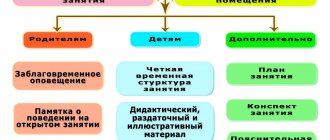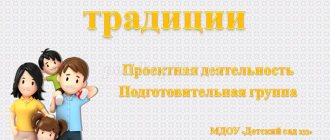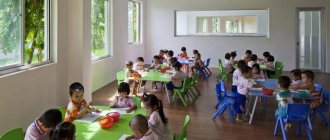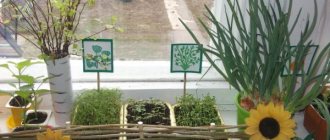Project "Our Pets"
Project "Our Pets"PROJECT TYPE: short-term
GROUP: Senior group No. 1
IMPLEMENTATION DATES: November 16-20
PROJECT PARTICIPANTS: children, parents of pupils, teachers
FINAL EVENTS: Design of a photo newspaper «
Our pets"
INTEGRATION OF EDUCATIONAL AREAS:
Cognitive development, speech development, social-communicative, artistic-aesthetic, physical
RELEVANCE
It's hard to imagine our life without pets. We are used to four-legged friends. They live nearby, give us their affection, warmth, affection, inspiring gratitude and kindness in our hearts. Therefore, developing a caring and caring attitude towards animals is of great importance in a child’s life. The animal world is extremely attractive; animals in the house are an important factor in education. This is not surprising, because every mother and every father wants their children to be kind, warm-hearted, and responsive. Chuck Palahniuk rightly noted: “Humanity is determined not by how we communicate with people, but by how we behave with animals.”
. By involving a child in joint activities to care for pets, adults develop in him sensitivity, the ability to understand other lives, encourage empathy, and cultivate a willingness to help in action.
EXPECTED RESULT
As a result of the project “Our Pets”
Children will enrich and expand their knowledge about pets and their importance in human life. Parents will take an active part in the project and will see the significance of this topic for the development and formation of a humane attitude towards animals in children. The project will help strengthen parent-child relationships.
OBJECTIVE OF THE PROJECT:
To attract the attention of children and parents to the world of pets, to teach how to systematize the information received, reflecting a personal attitude, to promote the positive development of child-parent relationships.
TASKS:
expand children's ideas about pets, their appearance, lifestyle, behavioral characteristics, nutrition, maintenance, role and benefits in human life, teach them how to use them
foster humane treatment of animals
develop creative abilities, create a desire to independently search for answers to emerging questions
learn to follow the rules of safe behavior when interacting with animals, develop a conscious and responsible attitude towards your own safety and the safety of others
STAGE I – PREPARATORY
“What do we want to know” (problematic questions):
why do we need pets? why do dogs bite; why did man domesticate animals? why animals have different tails; why does a cat have soft pads on its paws? how to care for pets
“Share your knowledge ” (learning questions):
what animals can be kept at home; what is the role of pets in people's lives; what can we give to pets
A selection of fiction and folklore:
«
First hunt" by V. Bianchi;
“The Cat Walked By Itself” by R. Kipling; “Who said “meow” V. Suteev; “About a cat ”
by V. Prikhodko;
“Kitten” V. Berestov; “Sporting Animals ”
by K. Ushinsky;
“
Puppy
”
I. Logerev.
Fairy tales: “Cat - gray forehead, goat and ram”, “Cat, rooster and fox”
Nursery rhymes: “Our ducks in the morning”, “Cat’s house”.
Counting tables: “Who counts?” M. Karem, «
A goat walked along the bridge
»
.
Riddles about pets.
Didactic games, puzzles, outdoor games, construction, exercises:
“I know 5 names of pets”
,
“Who has whom?”
,
“Who eats what?”
,
"What is missing?"
,
“Finish the sentence”
,
“Cats”
,
“Dogs”
,
“Cubs”
,
“Mice and the cat”
,
“Who said meow
?”,
“Mousetrap”
,
“Dog kennel”
,
“Guess who I am?”
Working with parents:
Mini-questionnaire “Does the family have pets? Which?"
(find out how many families in the group have pets, which ones are the most popular in families, the attitude of children towards animals.
STAGE II – BASIC, PRACTICAL
Children looking at postcards and pictures: “In the world of cats”
,
“Four-legged friend”
,
“Pets”
.
Reading fiction and folklore with children (listed above)
Organization of the role-playing game “Family”
(plot “At the veterinarian’s appointment” )
.
Conducting didactic games, physical exercises, outdoor games, making puzzles (listed above)
Conversations with children: “Pets”
(enrich children’s knowledge about pets, their lifestyle, role in people’s lives);
“We are responsible for those we have tamed”
(to instill in children a caring attitude towards pets, a sense of responsibility);
“Safety rules”
(teach children the rules of their own safety when handling animals;
“They are so different...”
(enrich children’s knowledge about pets using the example of cats and dogs
)
;
“Our friend is a dog”
(tell children about the role of dogs in human life );
“My affectionate and gentle animal”
(to expand children’s knowledge about cats, develop cognitive interest);
“My pet four-legged friend”
(to generalize children’s knowledge about pets, to activate vocabulary)
Guessing riddles about pets.
Work in the creative workshop:
Origami "Cat"
,
“Dog”
,
“Fish”
(teach children to convey pets in a constructive way, develop imagination, aesthetic taste)
Drawing “Mustachioed and Striped”
(teach children to convey the image of a literary hero)
Modeling “My favorite pet”
(continue to develop in children the ability to sculpt animal figures)
Working with parents
:
joint creativity with children “My pet four-legged friend”
consultations: “Four-legged therapists”
,
“Mom, I want a dog!”
,
“If a child shows cruelty to animals”
STAGE III - FINAL
“Our Pets” together with parents
. (show and tell friends and parents about your pets, cultivate a love for animals; those who wish can draw their favorite pet)
CONCLUSIONS
This project opened up the wonderful world of pets to children and parents. He contributed to thinking about the relationship between people and animals, helping to answer the questions “What place do pets occupy in our lives?”
,
“What do they bring to our lives?”
,
“What can we give them?”
.
The project expanded children's knowledge about the characteristics of pets, their role in human life, and emphasized the need for a humane attitude towards animals. The project helped us find out how many families in the group have pets, what types of pets are most popular in families ,
and what needs to be done to ensure that our pets have a good life. The created project made it possible to develop the creative thinking of preschool children, the ability to acquire knowledge from various sources, analyze facts, and express their own judgment. Thanks to the work done, children developed a strong interest in pets, their knowledge on this topic was consolidated and improved, and active involvement of parents in the pedagogical process and positive parent-child relationships were noted.
Bondarenko T.M. Environmental activities for children aged 6-7 years. Voronezh, 2004.
Zolotova E.I. We introduce preschoolers to the world of animals. – M., 2008.
Kolomina N.V. Education of the fundamentals of ecological culture in kindergarten. – M., 2003.
Molodova L.P. Environmental activities with children. – M., 2006.
Journey into the natural world. Games by Natalia Ryzhova in environmental education of preschoolers. Preschool education, No. 6, 2008
Ryzhova N.A. Our home is nature. M, 2002
Short-term project “Pets”
Directorate of General Education Administration
Rtishchevsky municipal district of the Saratov region
MUNICIPAL PRESCHOOL EDUCATIONAL INSTITUTION
“KINDERGARTEN No. 2 “BEE”, RTISHCHEVO, SARATOV REGION”
(MDOU kindergarten No. 2, Rtishchevo)
Short-term project
Topic: “ Pets”
Educator: Bulaeva E.N.
Date: 12/11/2017 until 12/15/2017
Relevance of the chosen topic.
A pet in a family is a powerful educational factor. The child learns to take care of him, look after him, he develops moral, volitional and labor qualities. This is not surprising, because every mother and every father wants their children to be kind, warm-hearted, and responsive. According to the scientist, “A person who does not love animals, who has never shown concern for them, cannot be kind.” By involving a child in joint activities to care for pets, adults develop in him sensitivity, the ability to understand other lives, encourage empathy, and cultivate a willingness to help in action. Children living in the city are mostly familiar (have in their families) with such representatives of domestic animals as cats, dogs, parrots. What other pets are there? In what conditions do they live, what benefits do they bring to humans, who are their cubs, what do they eat? To solve this problem, the “Pets” project arose. Project type:
cognitive - creative, short-term.
Project goals:
• Formation of children's ideas about pets, the conditions for keeping and caring for them.
• Fostering a humane and caring attitude towards animals. • Creating conditions for increasing the active participation of parents in the life of the group. Project objectives:
• To foster a humane attitude towards animals.
• Clarify children's ideas about domestic animals, their appearance, what voices they cast, where they live, what they eat, and what benefits they bring. • Development of speech, thinking, imagination, curiosity, enrichment of children's vocabulary. • Encourage children to turn to adults with questions, judgments, and verbal communication with each other. • Improving creative skills in children. • Creating a visual image in children, evoking an emotional response. Project participants:
children of secondary group No. 2, teachers and parents.
Implementation period:
1 week
Expected result:
• Enrichment of children's knowledge about the animal world of their immediate environment.
• Familiarity with the rules of caring for pets. • Instilling in children love and respect for animals. • Increasing the pedagogical literacy of parents in matters of nurturing children's caring attitude towards animals. • Active participation of parents in the affairs of the group and kindergarten Implementation of the project. 1.Preparatory stage.
• Make children and their parents aware of the importance of the problem.
• Select methodological, educational, fiction, and illustrative materials on this topic. • Select materials for play activities. • Select the necessary materials for creative and productive activities. • Draw up a long-term action plan. Problematic questions are formulated:
• How would we live without pets?
• Why keep animals in the house? • What happens if we release a pet into the wild? • Why did man domesticate animals? • If they live in a house, does that mean they are domestic? • True friends or helpers? • How to care for pets? Educational questions are formulated:
• What animals can be called domestic?
• What animals can you keep at home? • What is the role of pets in people's lives? • What can we give to pets? 2. Practical stage.
The project was carried out taking into account the principle of integration of educational areas in the organization of all types of children's activities: play, communication, work, cognitive - research, productive, musical - artistic.
Long-term action plan
| Day of the week/date | Ongoing events |
| Monday/12/11/2017 |
Finger games: “Goat”, “Pussy”. Outdoor games: “Who Shouts”, “Horse”. Didactic games: “Who lives where”, “Who shouts how”. Game exercises: “Complete the animal.”
|
| Tuesday/12/12/2017 |
“What Animals Love” - artist M. Bondarenko.
Finger games: “Meadow”, “Horse”. Outdoor games: “Vaska the Cat and the Mice”, “Teremok”. Didactic games “Who eats what?”, cut lotto “Animals”.
|
| Wednesday/12/13/2017 |
Finger games: “Horse”, “2 kittens”. Outdoor games: “Horse”, “Geese-geese”. Didactic games: “In the barnyard”, “Help the animals find their breakfast. Game exercises: “Choose an animal.” |
| Thursday/12/14/2017 |
Drawing – “Puppy”.
|
| Friday/12/15/2017 |
|
| Working with parents | |
| |
Consultation for parents:
"Children and Pets"
Intellectual development
* Animals are the source of the first knowledge about nature. A child sees an animal - he is drawn to it, recognizes its names, notes differences, and learns its behavior.
* Animals are the source of sensory development. No educational toy can compare to nature. The child directly through the senses perceives an object: shape, size, color, smell, spatial arrangement, movement, softness, texture of fur, etc.
* Animals are a source of development of logical thinking. Based on ideas about animals, children learn to see connections and dependencies: a kitty meows at a bowl - hungry, a ferret jumps high, gurgles - wants to play, hides - it hunts.
* Animals are a source for various types of activities - observation, play, work, creativity, etc. As a result, curiosity and observation are formed, and imagination develops.
Animals are a source of moral education
* Source of first experiences and joy. The child experiences positive emotions in communication with the animal. In modern society, this is precisely what is lacking most of all—positive experiences.
* In the process of communication, the child develops a sense of beauty. They learn to see natural beauty.
* In the process of activity, the child learns to show a careful (passive) and caring (active) attitude towards the animal world as a whole. In this way, the child develops the foundations of an ecological culture, which is an integral part of spiritual culture.
Animals are a source of aesthetic education and development
* Natural and natural beauty encourages children to be creative. Children love to reflect their experiences with animals in children's poems, stories of their own composition and, of course, in art activities.
Source of labor education
During the observation process, the child becomes familiar with simple labor operations. Under the guidance of adults, he develops basic skills in caring for animals. Additional information is acquired about living conditions in nature and at home.
Source of physical development
Animals are a source of health promotion and mental development: in the process of walking with a dog, ferret, rabbit, etc., in the process of work, children also improve physically.
Memo for parents:
“What are the dangers of pets for children?”
Even adults are touched when looking at a kitten or puppy. You want to pick him up, stroke him, kiss his pink nose. What to expect from children? For a child, a pet is not just an object of adoration and a play partner. A kitten, puppy or guinea pig becomes a friend for a child. He is in close constant contact with him, takes him to bed with him, feeds him from his spoon (while his parents are not looking). Without focusing on possible allergies or animal bites, let's talk about the invisible danger.
Even if a pet lives in the house and does not go anywhere, this does not guarantee that it is a carrier of parasitic diseases. Coming from the street, you can bring pieces of soil on the sole of your shoes where infected animals have walked.
Toxocariasis
- a disease that a baby can catch from a dog. Parasites can enter the child’s body if, after playing with the puppy, he does not wash his hands and sit down at the table. The larvae penetrate the intestinal walls, spread through the circulatory system, and from there they are transferred to the lungs, liver and even the eyes. The disease can be asymptomatic, causing only mild discomfort. Toxocariasis requires consultation with a parasitologist and the appointment of anti-parasitic devices.
Toxoplasmosis
– a disease that a child can catch from a cat. The eggs of parasites enter the intestines and grow there, turning into larvae. They penetrate the lymphatic system and spread throughout the body. They destroy internal organs and systems. In 80-90% of cases, toxoplasmosis does not produce obvious symptoms. But this disease poses the greatest danger to pregnant women.
Psittacosis
– a disease that a child can contract from birds (parrots, canaries, pigeons). More than 140 species of birds are carriers of the causative agent of this disease - chlamydia psitachi. Moreover, the birds themselves do not suffer from ornithosis. Birds shed chlamydia in nasal secretions and feces. Infection occurs when a child feeds the parrot mouth to mouth. If the cage has not been cleaned for a long time, the bird, flapping its wings, spreads dust and particles of infected feces around the room. A child can inhale this dust, the pathogen will enter the respiratory tract and cause a special type of pneumonia.
Memo for parents:
“How to protect a child from parasites transmitted by pets?”
— Never feed animals raw meat.
— Try to put all your shoes in the shoe closet when you get home.
— Once a year, have your animal examined at a veterinary clinic.
- Make sure your child washes their hands before eating. Better yet, teach your child to wash his hands with soap after each contact with an animal.
- Keep the birdcage clean.
— When cleaning the cat’s cage or litter box, put a medical mask on your face.




